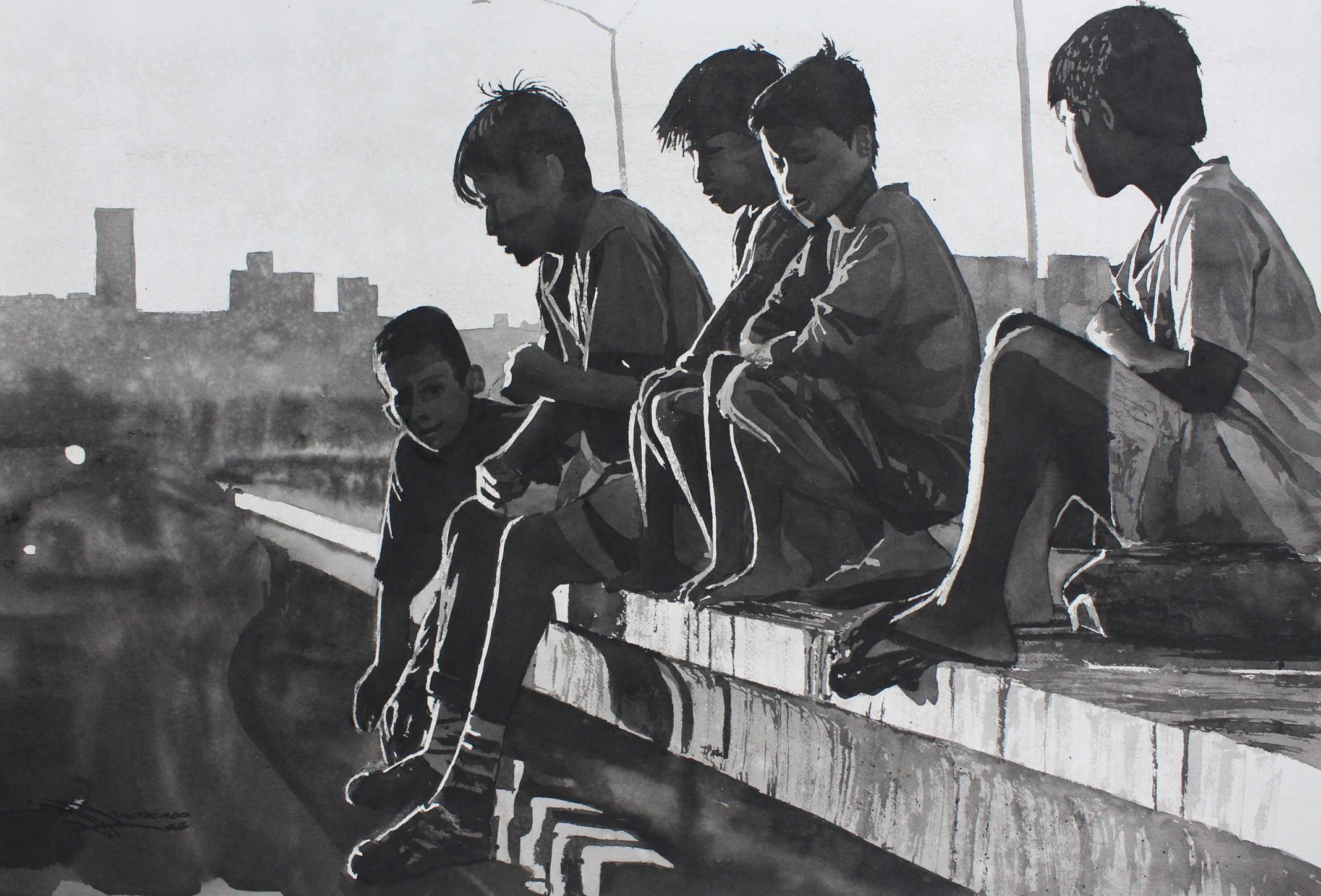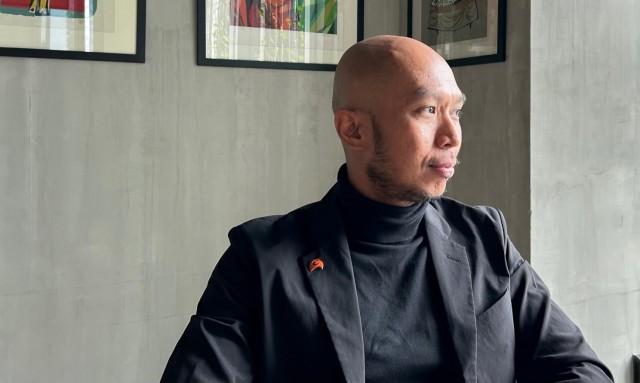These paintings are made with pigments from pollutants found in Metro Manila air

Enough smog blanketed Metro Manila in late September that classes had to be suspended for a day. It was more than enough to remind residents of what we’ve long known: Metro Manila’s air quality isn’t particularly the best.
Now here comes an art exhibit providing the most compelling imagery and driving home the point: “Polluted Palette” features 37 paintings made with pigments from Metro Manila air pollutants.
It is a one-man show of artist and architect JC Vargas, who harvested pollutants from Metro Manila air, turned those into pigment and painted familiar Metro Manila scenes using exactly that.
Speaking to GMA News Online, JC explained they “took different kinds of air pollutants: Indoor dust, outdoor dust, and soot from vehicles. I mixed them with gum arabic, a natural binder and that became the water color pigment.”
They first harvested outdoor dust, using filters donated by Menarco Tower. Pointing to the building intakes from where outside air flows into the building, JC said the intakes come equipped with filters so the air coming into the building is cleaned. “Parang aircon, ‘di ba, may filters din yon. Menarco Tower donated those filters so we can say the outdoor dust is from Taguig,” he said.
Then he collaborated with Indoor Air Quality Philippines (IAQ) to collect indoor dust. “Normally sa construction, before the tenants come in, nagkakaroon ng indoor air flush out to remove all the used air of the construction site, yung dust of the building. IAQ does that kind of flushing. They donated their filters, equivalent to a pint’s worth of dust, and that’s the pigment na nagbibigay ng sepia tone sa mga paintings,” he continued.
Finally, JC and his team approached and collected soot from diesel cars, tricycles, and jeepneys in the Pioneer area at the Pasig-Mandaluyong border, which provided a very rich kind of black. “The dark pigments from soot is so rich. You only need to use little. Ganun siya katindi,” he said.
Because the pigments made from pollutants “didn’t undergo any decontamination process, I used the pollution directly,” JC knew he had to wear protective gear like gloves and a mask while working on the paintings after-hours.
Removing his mask while working on his third painting of the series was a revelation. “I couldn't smell anything but after several minutes, my throat started itching.”
“Hindi mo siya nakikita, hindi mo siya naaamoy pero nararamdaman mo siya, and I think most of people, they will say, makati lalamunan nila, baka may something but I think a big part of that comes from our air quality,” he said, casually pinpointing health implications of air pollution. In fact, according to the United Nations Environmen Programme (UNEP), air pollution “accounts for an estimated 7 million premature deaths every year.”
JC says even indoor dust is just as dirty. Just a scoop of indoor dust revealed many other types of debris. “And dami kong nakita — may mga buhok pa,” he said amused at the, well, trash he collected.
From familiar scenes of street children to pigments derived from Metro Manila air, it is safe to say “Polluted Palette” has been influenced by his time spent on the road, on his bike, as he made his way from his Mandaluyong address to his Makati office.
JC shares he decided to bike to work pre-pandemic “because back then nung wala pa yung bridge, walang ibang public transportation option para makatawid papuntang kabila. Kailangan mo mag-Grab or magpapalit-palit ng sakay.”
Quickly he noticed something different. “Every two to three days, I would clean my nose, and it was black,” he said. Instinctively, he knew it was from the pollution on the road.
When the pandemic took place and he continued his biking commute, he observed cleaning his nose was “white na ulit.” And when the world opened up again, and “naging black na ulit siya.”
JC said cleaning his nose became something of a personal gauge meter. “Duon ko nakikita yung changes in the quality of air. Yung katawan ko na mismo yung nagsasabi na ganun nga yung air quality na meron tayo.”
Quickly relating it to the street children he constantly sees on the road, JC says “it’s quite alarming na exposed sa ganung air quality. Duon ko naisip na kailangan ko mag-send ng message.”
In the course of the interview, he says street children and air pollution are so common “hindi na natin sila napapansin.”

The artist says being an architect was an accident and he credits his day job for informing and influencing his art. “I think malaking part yung pagiging consultant ko sa Arcadis,” began the artist, who is employed by the design and construction firm that also helped in constructing the Menarco Tower in BGC. “Kasi if wala yun, hindi ko ma-di-discover and ma-a-access yung mga filters ng buildings.”
After the idea for “Polluted Palette” crystallized in his mind last year, he pitched the idea to his company, which has an employee engagement program, Local Sparks, that supports employees with unique ideas that can touch societal issues.
While “Polluted Palette” sends a strong message, especially after recent vehicular emission-caused smog in Metro Manila, JC didn’t have anybody in mind. “I think it’s for everyone. Maraming factors. Nung pandemic, um-okay yung air quality natin, so may chance na kaya nating gawin. But we have to make that effort.”
He mentions developers and suggests “building or constructing in a cleaner way. “We can use painting materials with low volatile organize compounds (VOC) because that is be harmful sa air quality,” he said.
He also points out car drivers and says, “kung malapit lang naman ang pupunthan mo, baka may other ways to go there na hindi ka mag-e-emit ng pollution or ng soot. Pwede ka maglakad or mag-bike. I think malaking impact nun,” he said.
“So meron for individuals, meron for developers. It’s not just for a particular group. It’s for everyone because this is the air that we breathe. It’s all of us,” he said.
“Hindi siya simpleng bagay. Madali siyang sabihin pero kailangan mo talaga mag-effort para ma-address yung issue,” JC continued. “Hindi biro na from the conventional na may sasakyan ka, ipagba-bike ka. Ang hirap niyang gawin pero kung yung lang yung way, para ma lessen yung pollution, then that's the solution.”
[It's not a simple thing. It's very easy to say but you really need to exert effort to address the issue. It's not a joke to tell car drivers to bike instead. It's hard to do but if it's the only way to lessn the pollution, then that's the solution.]
Perhaps this is where government intervention comes in. A 2016 study by the National Association of City Transportation Officials in the US revealed protected bike lanes “significantly increases bike ridership on this streets,” helping further the artist's suggested solution.
Thankfully, the government is slowly getting it. At the launch of 2023 National Bike Day, DOTr Assistant Secretary for Road Transport and Infrastructure James Melad said "[cycling] is a statement about choosing a lifestyle that promotes health, reduces our carbon footprint, and fosters a sense of community."
While the city's air has improved since then, JC’s message and insight are especially timely as the world struggles to mitigate the climate crisis and tries to collectively bring down greenhouse gas emissions to abide by the 1.5C warming of the 2015 Paris Agreement.
“Air pollution and climate change are closely linked as all major pollutants have an impact on the climate,” UNEP says on its website. Mainly derived from burning fossil fuels for electricity and transportation, greenhouse gas emissions are a form pollution that harms not just the environment but humans as well — as JC earlier pointed out.
This isn’t the first time JC looked to nature for his art. In 2016, he was part of the group exhibition that used riverine water for their art works. “They even hired a chemist that collected water from different rivers that we all used. There was water from Tulyahan, Marikina, Pasig, and surprisingly the darkest water came from Taguig,” he says amused. “I think it’s because maraming tao, maraming nangyayari kaya ganun yung quality ng tubig.”
He says he doesn’t have any concrete plans for the future though “anything related to the environment and community, tingin ko yun yung path ko.”
“I have something on water, I have something on air. Who knows baka lupa — baka bundok, baka mining. Hindi natin alam.”
“Polluted Palette” on display at the Menarco Vertical Museum in BGC until October 7.
— GMA Integrated News




